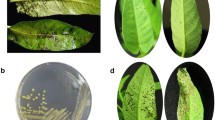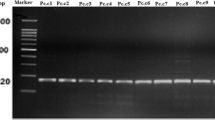Abstract
Bacterial contamination of fresh tomato fruits is of great concern. From naturally infected tomato fruits showing dark brown irregularly shaped spots, 36 bacterial isolates were recovered and identified on phenotypic characteristics and sequences of the gene encoding the 16S rRNA. Five isolates showing spots on tomato fruits in the pathogenicity test with healthy tomato fruits belong to the genus Serratia on the basis of phenotypic characteristics. One representative isolate of these has been further identified as a Serratia rubidaea by sequencing of the 16S rRNA gene. This is the first evidence showing that a S. rubidaea strain can cause spots on tomato fruits. Virulence of the S. rubidaea was also confirmed by the production and secretion of a large variety of enzymes capable of degrading the complex polysaccharides of the plant cell wall and membrane constituents. Nineteen bacterial isolates of the 36 did not induce any spot symptoms in a pathogenicity test on artificially infected tomato fruits although these are known as phytopathogenic bacteria. Five of these 19 bacterial isolates were identified as Ralstonia species on the basis of biochemical tests. Sequencing of the 16S ribosomal gene of one representative isolate revealed that the isolate is closely related to Ralstonia solanacearum. Six isolates of the 19 were related to Xanthomonas vesicatoria on the basis of biochemical tests and eight were related to the Enterobacteriaceae. One representative isolate of the Enterobacteriaceae could be identified by the 16S rRNA gene as Enterobacter cloacae subsp. dissolvens. The 12 other strains were related to Proteus mirabilis based on the 16S RNA gene sequence of one representative isolate. The isolates related to P. mirabilis did not produce any symptoms on artificially infected tomato fruits. The nucleotide sequences of S. rubidaea strain E9, E. cloacae strain E23, P. mirabilis strain E11, and R. solanacearum strain E15 have been deposited in the GenBank nucleotide sequence database under accession numbers HM585373 to HM585376.



Similar content being viewed by others
References
Abd-Alla, M. H. (1994). Phosphatases and the utilization of organic phosphorus by Rhizobium leguminosarum biovar viceae. Letters in Applied Microbiology, 18, 294–296.
Abd-Alla, M. H., & Bashandy, S. R. (2008). Bacterial wilt and spot of tomato caused by Xanthomonas vesicatoria and Ralstonia solanacearum in Egypt. World Journal of Microbiology & Biotechnology, 24, 291–292.
Abd-Alla, M. H., Bashandy, S. R., & Schnell, S. (2010). Occurrence of Xanthomonas axonopodis pv. phaseoli, the causal agent of common bacterial blight disease, on seeds of common bean (Phaseolus vulgaris L.) in Upper Egypt. Folia Microbiologica, 55, 47–52.
Baharum, S. N., Salleh, A. B., Razak, C. N. A., Basri, M., Rahman, M. B. A., & Rahman, R. N. Z. R. A. (2003). Organic solvent tolerant lipase by Pseudomonas sp. strain S5: stability of enzyme in organic solvent and physical factors affecting its production. Annals of Microbiology, 53, 75–83.
Bateman, D. F., & Basham, H. G. (1976). Degradation of plant cell walls and membranes by microbial enzymes, Vol. 4, pp. 316–355. In R. Heitefuss & P. H. Williams (Eds.), Encyclopedia of plant physiology. New York, NY: Springer.
Benson, D. A., Karsch-Mizrachi, I., Lipman, D. J., Ostell, J., & Wheeler, D. L. (2008). GenBank. Nucleic Acids Research, 36, D25–30.
Berg, G. (1996). Rhizobacteria of oilseed rape antagonistic to Verticillium dahliae var. longisporum Stark. Journal of Plant Diseases Protection, 103, 20–30.
Berg, G., Eberl, L., & Hartmann, A. (2005). The rhizosphere as a reservoir for opportunistic human pathogenic bacteria. Environmental Microbiology, 7, 1673–1685.
Blostein, J. (1993). An outbreak of Salmonella javiana associated with consumption of watermelon. Journal of Environmental Health, 56, 29–31.
Bollet, C., Gulian, C., Mallet, M. N., Estrangin, E., & de Micco, P. (1989). Isolation of Serratia-Rubidaea (Stapp) from fresh and spoiled coconuts. Tropical Agriculture, 66, 342–344.
Brenner, D. J., Krieg, N. R., Staley, J. T., & Garrity, G. M. (Eds.). (2005). Bergey’s manual of systematic bacteriology. New York, NY: Springer.
Cappellini, R. A., Ceponis, M. J., Wells, J. M., & Lightner, G. W. (1984). Disorders in potato shipments to the New York market, 1972–1980. Plant Disease, 68, 1018–1020.
Ceponis, M. J., Cappellini, R. A., & Lightner, G. W. (1985). Disorders in crisphead lettuce shipments to the New York market, 1972–1984. Plant Disease, 69, 1016–1020.
Ceponis, M. J., Cappellini, R. A., & Lightner, G. W. (1986). Disorders in tomato shipments to the New York market, 1972–1984. Plant Disease, 70, 261–265.
Ceponis, M. J., Cappellini, R. A., & Lightner, G. W. (1987). Disorders in fresh pepper shipments to the New York market, 1972–1984. Plant Disease, 71, 380–382.
Chakraborty, R., & Srinivasan, M. (1993). Production of a thermostable alkaline protease by a new Pseudomonas sp. by solid substrate fermentation. Journal of Microbial Biotechnology, 8, 7–16.
De Roever, C. (1998). Microbiological safety evaluations and recommendations on fresh produce. Food Control, 9, 321–347.
Ercolani, G. L., & Casolari, A. (1966). Ricerche di microflora im pomodori sani. Industrie Conserve Parma, 41, 15–22.
Ewing, W. H., Davis, B. R., Fife, M. A., & Lessel, E. F. (1973). Biochemical characterization of Serratia liquefaciens (Grimes and Hennerty) Bascomb et al. (formerly Enterobacter liquefaciens) and Serratia rubidaea (Stapp) comb. nov. and designation of type and neotype strains. International Journal of Systematic Bacteriology, 23, 217–225.
Fadiloğlu, S., & Söylemez, Z. (1997). Kinetics of lipase-catalyzed hydrolysis of olive oil. Food Researcher International, 30, 171–175.
Felsenstein, J. (1989). PHILIP - Phylogeny inference package (version 3.2). Cladistics, 5, 164–166.
Gomes, I., Saha, R. K., Mohiuddin, G., & Hoq, M. M. (1992). Isolation and characterization of a cellulase-free pectinolytic and hemicellulolytic thermophilic fungus. World Journal of Microbiology & Biotechnology, 8, 589–592.
Gonzalez, C. F., Pettit, E. A., Valadez, V. A., & Provin, E. M. (1997). Mobilization, cloning, and sequence determination of a plasmid-encoded polygalacturonase from a phytopathogenic Burkholderia (Pseudomonas) cepacia. Molecular Plant-Microbe Interactions, 10, 840–851.
Grimont, P. A. D., Grimont, F., & Starr, M. P. (1981). Serratia species isolated from plants. Current Microbiology, 5, 317–322.
Guo, X., Chen, J. R., Brackett, R. E., & Beuchat, L. R. (2001). Survival of Salmonellae on and in tomato plants from the time of inoculation at flowering and early stages of fruit development through fruit ripening. Applied and Environmental Microbiology, 67, 4760–4764.
Immanuel, G., Esakkiraj, P., Jebadhas, A., Iyapparaj, P., & Palavesam, A. (2008). Investigation of lipase production by milk isolate Serratia rubidaea. Food Technology and Biotechnology, 46, 60–65.
Kroupitski, Y., Golberg, D., Belausov, E., Pinto, R., Swartzberg, D., Granot, D., et al. (2009). Internalization of Salmonella enterica in leaves is induced by light and involves chemotaxis and penetration through open stomata. Applied and Environmental Microbiology, 75, 6076–6086.
Ludwig, W., Strunk, O., Westram, R., Richter, L., Meier, H., Yadhukumar, et al. (2004). ARB: a software environment for sequence data. Nucleic Acids Research, 32, 1363–1371.
Lund, B. M. (1983). Bacterial spoilage. London, UK: Academic.
Ohara-Nemoto, Y., Sasaki, M., Kaneko, M., Nemoto, T., & Ota, M. (1994). Cysteine protease activity of streptococcal pyrogenic exotoxin-B. Canadian Journal of Microbiology, 40, 930–936.
Parment, P. A., Ursing, J., & Palmer, B. (1984). Serratia rubidaea isolated from a silastic foam dressing. Infection, 12, 268–269.
Rosen, H. R. (1922). The natural pathogen of corn stalk rot. Phytopathology, 12, 497–499.
Samish, Z., & Etinger-Tulczynska, R. (1963). Distribution of bacteria within tissue of healthy tomatoes. Applied Microbiology, 11, 7–10.
Samish, Z., Etinger-Tulczynska, R., & Bick, M. (1963). Microflora within tissue of fruits and vegetables. Journal of Food Science, 28, 259.
Schaad, N. W. (1988). Laboratory guide for identification of plant pathogenic bacteria. St. Paul, MN, USA: APS Press.
Sekhsokh, Y., Arsalane, L., El Ouenass, M., Doublali, T., Bajjou, T., & Lahlou Amine, I. L. (2007). Serratia rubidaea bacteremia. Médecine et Maladies Infectieuses, 37, 287–289.
Singh, B. R., Singh, Y., & Tiwari, A. K. (1997). Characterisation of virulence factors of Serratia strains isolated from foods. International Journal of Food Microbiology, 34, 259–266.
Snowdon, A. L. (1990). A color atlas of post-harvest diseases of fruits and vegetables. Boca Raton, FL, USA: CRC Press.
Stapp, C. (1940). Bacterium rubidaeum nov. spec. Zentralblatt für Bakteriologie, Parasitenkunde, Infektionskrankheiten und Hygiene, 102, 251–266.
Tyler, H. L., & Triplett, E. W. (2008). Plants as a habitat for beneficial and/or human pathogenic bacteria. Annual Review of Phytopathology, 46, 53–73.
Ursua, P. R., Unzaga, M. J., Melero, P., Iturburu, I., Ezpeleta, C., & Cisterna, R. (1996). Serratia rubidaea as an invasive pathogen. Journal of Clinical Microbiology, 34, 216–217.
Wei, C. I., Huang, T. S., Kim, J. M., Lin, W. F., Tamplin, M. L., & Bartz, J. A. (1995). Growth and survival of Salmonella montevideo on tomatoes and disinfection with chlorinated water. Journal of Food Protection, 58, 829–836.
Wright, C., Kominos, S. D., & Yee, R. B. (1976). Enterobacteriaceae and Pseudomonas aeruginosa recovered from vegetable salads. Applied and Environmental Microbiology, 31, 453–454.
Acknowledgments
This research was supported financially by Assuit University, Egypt.
Author information
Authors and Affiliations
Corresponding author
Rights and permissions
About this article
Cite this article
Abd-Alla, M.H., Bashandy, S.R., Schnell, S. et al. Isolation and characterization of Serratia rubidaea from dark brown spots of tomato fruits. Phytoparasitica 39, 175–183 (2011). https://doi.org/10.1007/s12600-011-0148-6
Received:
Accepted:
Published:
Issue Date:
DOI: https://doi.org/10.1007/s12600-011-0148-6




